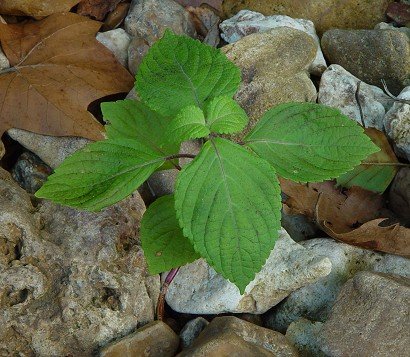Owing to the screen size of your device, you may obtain a better viewing experience by
rotating your device a quarter-turn (to get the so-called "panorama" screen view).
|
Not yet updated for 2022.
|
Click here for the site directory.
|
|
Please consider linking to this site!
|
Click here to email us.
|
Perilla
(Perilla frutescens)
About Perilla

Perilla—aka Shiso, Japanese Basil, Rattlesnake Weed, Wild Coleus, and Beefsteak Plant—is an annual distantly related to the mints. There are two distinct types, green and red, which differ by more than just color—the green is apparently the “real” shiso, and has more flavor than the red or purple (which is nonetheless popular for its color). The taste of perilla is almost always said to be quite hard to describe—the words cinnamon, basil, anise, and citrus pop up in the attempts. That all sounds well worth a tryout (though a few report much disliking it). We’d stick to the true shiso, the Green Perilla, at least for starters. (There is also a sort of “bronze” type that seems by report to be just a minor color variant of green.)
It is worth noting that perilla is a very attractive plant, often grown simply for its ornamental value. It resembles a coleus, and indeed displays of it are sometimes marked This is not a coleus! The more sun it gets, the more colored up it tends to be (though that may apply more to the red perilla than to shiso).
Cultivars
At this stage, cultivars beyond the color differences seem unknown to U.S. seedsmen, who usually list the plant in their “herbs” sections as just “Green perilla”.
Planting
Perilla is a warm-weather plant, and its culture is apparently simple: direct-seed it when frost risk is past, say around June 1st. Figure on the traditional square foot per plant.
Beware! perilla is highly invasive! It grows as an aggressive weed [PDF document—slow to load]. It is most unwise to grow it outdoors, no matter how much care is taken about seeds dropping.
On the other hand, it makes an excellent indoor-growth container plant, and that is really the only acceptable way to grow it.
Growing
Though one grows it for the leaves, the flowers are also edible, and might make a pleasant garnish. As with any potherb, to use it in salads, pick the leaves when still young and small (pick from the top of the growing plant).
Relevant Links
Besides any links presented above on this page, the following ought to be especially helpful.
More
Odds and Ends
Biology
Perilla is a member of the Labiatae family, a very large one that includes many common herbs: the basils, the mints, lavender, hyssop, pennyroyal, lemon balm, horehound, and several less-known species.
History
The history of perilla/shiso is not much discussed on the web. It appears to have been a staple of the Japanese diet for millennia, dating from sometime in the Jomon Era—which, regrettably, is a sorta wide window: 8000 B.C. to 400 B.C.
Envoi
In Japan, perilla leaves are sometimes used as a pizza topping.
Return to the top of this page.
If you find this site interesting or useful, please link to it on your site by cutting and pasting this HTML:
The <a href="https://growingtaste.com/"><b>Growing Taste</b></a> Vegetable-Gardening Site
—Site Directory—
Search this site, or the web
-
Background Information
about the purposes and design of this site
- Site Front Page
-
Introduction

- An Apologia: why one should cultivate one's garden
- Deep-Bed Gardening (forthcoming)
- Container Gardening (forthcoming)
- Vegetarian and Organic Considerations (forthcoming)
-
Recommended Crops for a home garden, by variety
-
Gardening information and aids
-
Miscellaneous Information of interest to the home gardener
Since you're growing your own vegetables and fruits, shouldn't you be cooking them in the best way possible?
Visit The Induction Site to find out what that best way is!
|
If you like good-tasting food, perhaps you are interested in good-tasting wines as well?
Visit That Useful Wine Site for advice and recommendations for both novices and experts.
|

|
This site is one of The Owlcroft Company family of web sites. Please click on the link (or the owl)
to see a menu of our other diverse user-friendly, helpful sites.
|
|
 Like all our sites, this one is hosted at the highly regarded Pair Networks,
whom we strongly recommend. We invite you to click on the Pair link for more information on getting your site or sites hosted on a first-class service.
Like all our sites, this one is hosted at the highly regarded Pair Networks,
whom we strongly recommend. We invite you to click on the Pair link for more information on getting your site or sites hosted on a first-class service.
|
|
All Owlcroft systems run on Ubuntu Linux and we heartily recommend it to everyone—click on the link for more information.
|
Click here to send us email.
Because we believe in inter-operability, we have taken the trouble to assure that
this web page is 100% compliant with the World Wide Web Consortium's
XHTML Protocol v1.0 (Transitional).
You can click on the logo below to test this page!
You loaded this page on
Friday, 18 April 2025, at 22:07 EDT.
It was last modified on Monday, 10 January 2022, at 06:53 EST.
All content copyright ©1999 - 2025 by
The Owlcroft Company

